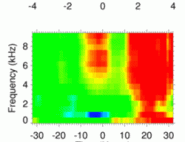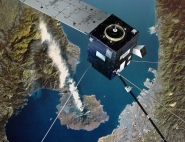On the scientific use of a service instrument of the DEMETER satellite
There was onboard Demeter many scientific instruments which have been used to study the ionospheric parameters. But other instruments have also performed measurements for the attitude control of the satellite as the fluxgate magnetometer. This magnetometer has evaluated the 3 components of the Earth's magnetic field at the satellite altitude. Due to a low sampling rate (1 second) and a low resolution (50 nT), it was not used until now for the scientific studies undertaken with the satellite data. But in exceptional circumstances, exceptional data, and in November 2004, the Demeter satellite was afflicted by the largest magnetic storm of the entire mission. At this time, the magnetometer revealed, at high latitudes, a system of field-aligned currents in a density depletion related to waves named auroral kilometric radiation (see Figure). More details are given in:
Parrot, M., and J.-J. Berthelier (2012), AKR-like emissions observed at low altitude by the Demeter satellite, J. Geophys. Res., 117, A10314, doi:10.1029/2012JA017937.
Figure: from the top to the bottom: The three magnetic field components Bx, By, Bz in the satellite coordinate system, the electron density, and the O+ ion density as function of the time. The parameters below are the universal time (UT), the local time (LT), the latitude and the longitude, and L the McIlwain parameter which is linked to the magnetic field. One can see the density variation which is simultaneous with the magnetic field variations. |

